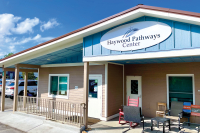Thinking bigger: After 45 years, MST vision keeps growing

Jutting off from the left side of a typically busy Blue Ridge Parkway pull-off overlooking Mills River, an unassuming dirt path dips into the woods and winds its way east, just out of view of the famed scenic drive.
In a month or so, flowers and newly birthed leaves will splash color through the forest, and eager undergrowth will paint over the woodland floor, now plastered with dead brown leaves. Today, though, the trees are still bare, an assertive cold front staving off spring’s arrival. I’m wearing thermal leggings under my hiking pants, a knit hat and three layers on top. Snowflakes shaped like tiny snowballs drift through the air, melting in disappointment as they meet ground that’s just barely too warm to hold them.
But despite the chill, portents of spring abound — for those willing to slow down enough to see them. Patches of showy white bloodroot flowers burst through thick layers of decay. Orange columns of bear corn rise alongside last year’s crumbling remains. Close to the ground, the pink-white blooms of trailing arbutus poke out between leathery, evergreen leaves.
Observation, combined with imagination, make it possible to see what this place — one small link in the 1,175-mile Mountains-to-Sea Trail — will look like once the comforting nirvana of summer arrives.

Related Items
A 1977 article in The Mountaineer reports on Howard Lee’s speech proposing the MST. Haywood County Library photo
The vision
The MST itself is the result of that same kind of vision — the kind that sees beyond what is, to glimpse what could be. Stretching from Clingmans Dome on the Tennessee border to Jockey’s Ridge State Park in the Outer Banks, the long-distance trail exists because 45 years ago, one person had enough faith in the vision to name it publicly, and countless others had enough desire for its manifestation to devote their lives to making it reality.
Last week, MST leaders and enthusiasts from across the state converged on Lake Junaluska for Friends of the MST’s annual Gathering of Friends , a four-day event this year commemorating the trail concept’s 45th anniversary on the same stage where it was originally proposed on Sept. 9, 1977.
“I see myself as someone who does not see things as they are and simply ask, ‘Why?’” Howard Lee, who first proposed the concept 45 years ago, told the crowd filling Shackford Hall Saturday, April 9. “I’ve always dreamed of things that have never been and asked, ‘Why not?’”
Now 88, Lee was in his early 40s when he made his infamous speech at Lake Junaluska. But his “why not?” attitude began much earlier, when he was a Black child growing up under Jim Crowe oppression in Georgia.
“I’d go to the segregated high school, sit at a used desk using used books and people would say, ‘I don’t know why you’re getting an education. You’re not going to get a decent job. You’re never going to be hired at a high-level position, and you’re never going to be able to rise higher in society,’” he said. “My question was always, ‘Why not?’”
Lee proved the detractors of his younger years wrong, earning a master’s degree at UNC Chapel Hill and then becoming the city’s mayor in 1969. After unsuccessful runs for Congress in 1972 and lieutenant governor in 1976, he found political success as a state senator in 1990. But before that — just one year after losing the lieutenant governor race — Gov. Jim Hunt appointed him secretary of what was then called the Department of Environment and Natural Resources, making him the first Black man in the South to hold a state cabinet seat.
The appointment would prove transformational for Lee, but he almost turned it down. He’d wanted to lead the Department of Health and Human Services. He had no interest in natural resources.
“My wife talked to me and said, if you’re being offered an opportunity, why would you want to reject it?” he said. “I accepted. That was the best decision I think I’ve ever made in my life.”
Later that year, Lee found himself at Lake Junaluska, speaking as part of the fourth National Trails Symposium. There he proposed a state trail stretching 450 miles from the mountains to the coast, touching communities and natural areas alike. As reported in a contemporary article by Mountaineer writer Doug Clark, the trail would give visitors and residents alike “a real feel for the sights, sounds and people of this state.”
Completing the trail would be a long-term goal, Lee said, and it would take cooperation from federal, state and local government. But that collaboration “would speed us toward previously undreamed of recreation goals.” If other states followed suit, one day those separate state trails could link together to form a larger, national trail.
Lee “surprised perhaps even hardcore outdoorsmen” with the proposal, Clark wrote.

Hikers navigate a downhill section of the Mountains-to-Sea Trail near Bent Creek Gap Friday, April 8, during one of the outings organized for last week’s Gathering of Friends. Holly Kays photo
An idea with momentum
Lee even surprised the governor.
“A cabinet secretary does not go out and make proposals without clearing them with the governor’s office,” Lee said April 9. “I had not cleared this through Gov. Hunt’s office.”
He probably wouldn’t have done it at all if not for Jim Hallsey, who was seven years into his tenure with DENR at the time, and speechwriter Steve Meehan. They asked him to insert lines in the speech proposing the trail, and while it didn’t appeal to Lee at first, the more they talked about it the more enthusiastic he became.
“I made the proposal thinking, ‘It’ll go away. It won’t last,’” Lee said. “It just happened that a reporter from the Asheville newspaper was in the audience, and I was told that a big article was about to appear in the Asheville newspaper. I had to fly back into Raleigh that day and go straight to the mansion to have a meeting with Gov. Hunt. It was not a pleasant meeting.”
Thankfully, said Lee, their friendship recovered, but Hunt made it clear that no state money would be coming to fund Lee’s big idea. While Hunt later saw the value of the MST concept, recently telling Lee that launching the trail is what he’s most proud of from their time in office together, that conversation set the tone for a culture that continues to this day — throughout its history, the MST has been a shoestring operation fueled by volunteers, donations and the goodwill of land management agencies and private landowners.
“I made a speech. My heart was in it. I was committed to it, and in spite of the fact that some didn’t think it made sense, I did it anyway,” Lee said. “But the people who brought us here today deserve the full credit.”
Louise Chatfield , who chaired the N.C. Trails Commission at the time and was the first woman to do so, was the “principal spark plug” for the project, her son Bill told the audience April 9. She has since passed away but was known for her organizational skill and ability to identify local leaders who could carry a mission forward. She worked hard to generate awareness for the trail effort and organize press events to highlight it.
Lee also lifted up Doris Hammett , a Waynesville pediatrician with a passion for trails. Hammett is now 98, so her daughter Karen attended the April 9 event in her stead, recognizing her mother’s contributions to the statewide trail.
“Mom saw hiking as an activity families could do together, no matter the age,” she said. “Hiking is easily shared, and she encouraged this activity in her pediatric practice. It was difficult for her patients and her patients’ mothers to say no to this idea because it didn’t involve expensive gear and there was no cost to do it, and that was very important in a rural county that did not have a high income level at that time. So when Howard Lee suggested a trail across the state of North Carolina at the National Trails Symposium in 1977, that speech must have been really good, because that idea took fire in Mom.”
Hammett organized the Balsam-Highlands Task Force focused on trail-building in the western region, and while she didn’t build much trail herself, she was a gifted organizer. She planned meetings, wrote informational pieces for news media, and coordinated local efforts with those at the state level.
Jim Hallsey , who pushed Lee to make the speech that got him in the governor’s hot seat, spent countless hours to make the MST concept reality. Allen de Hart and John Lanman were also devoted trail builders and advocates. And Kate Dixon , recently retired as Friends of the Mountains-to-Sea Trail’s first director, took the mission to a whole new level.
“Kate is the one who actually provided the fuel that had this trail process kick off like most of us could not have envisioned,” Lee said.
Since Dixon took the helm in 2008, annual volunteer hours have multiplied from 13,000 in 2007 to 34,000 in 2019. She developed the Coastal Crescent route in the southeastern part of the state, where no new trail had been built for 30 years, and under her leadership more than 200 new trail miles were added, bringing the trail’s off-road total to 720 miles. The remaining portion of the 1,175-mile route still uses roadways. A fund established in her name aims to help continue what she started.

Howard Lee speaks to the Gathering of Friends Friday, April 8, at Lake Junaluska. Holly Kays photo
A new era
Friends of the MST recently welcomed Brent Laurenz as its new leader, signaling the start of a new era in the trail’s history.
“I’m coming into this sort of inflection point or transition point where it’s been 45 years and the trail’s amazing, and it’s gotten to this great place,” Laurenz said. “What is the next 45 years going to look like?”
That’s the million-dollar question. When Lee took the podium on Sept. 9, 1977, he envisioned a 450-mile trail where none existed. Four-and-a-half decades later, others have amplified his vision to encompass 1,175 miles, of which 455 still need to be moved off motor roads and into the woods. When Lee met with Hunt after the speech, he was told that no state money would go into trail construction. Now, trails enthusiasts are celebrating a 2021-2023 state budget committing $29 million to state trails projects.
“This money is so wonderful, but it’s also a really big challenge,” Dixon said while addressing the gathering April 9.
Throughout its history, Friends of the MST grew organically, taking one step at a time as resources allowed. Now, the little organization with a $400,000 annual budget is poised for rapid growth.
“All of a sudden we have $5 million that the state is looking to us to spend quickly to make really significant changes on the trail,” she said. “It’s a real big undertaking for this organization.”
In the western part of the state, the trail is complete — a continuous 361-mile section stretches from Clingmans Dome to Stone Mountain State Park. But farther east, roadside walking is common. Laurenz said that he’ll be focusing on filling those gaps, and on connecting the trail to existing neighborhoods and communities wherever possible.
“Next year is the Year of the Trail , and I think that there’s some really cool opportunities to promote both our trail, the MST, and also all the other trails across the state, to really continue to highlight the value they bring to the state and how to get out and use them,” he said.
That’s a focus shared by Reid Wilson, secretary of the N.C. Department of Natural and Cultural Resources. Access to trails and greenways is important for physical and mental health, but also for economic development. Increasingly, he said during an April 8 address to The Gathering of Friends, companies want locations that offer their employees easy access to outdoor amenities. Yet, in many parts of the state there are “big gaps.”
“We’re trying to figure out how to, at the very grassroots level in small communities, work with them so that we can help them create these wonderful recreational facilities where they live,” he said. “We want to make sure that everybody in the community can get in a car or on a bike and be in a park or on a trail in not that many minutes.”
In a panel discussion held later that evening, leaders from the Blue Ridge Parkway, Great Smoky Mountains National Park, U.S. Forest Service and N.C. State Parks also emphasized the importance of connectivity between the MST and the parks and communities it passes.
“We want to have these trails that are sustainable in terms of reducing any impacts to the resource, but also that they’re providing economic driver for the communities that are close by,” said National Forests in North Carolina Forest Supervisor James Melonas . “We joke sometimes that we have the world’s best trail network, but it’s not connected into the community in a way that they’re benefiting.”
With the Year of the Trail coming, said Blue Ridge Parkway Superintendent Tracy Swartout , the Parkway hopes to start prioritizing trail construction and maintenance in a way the road-centric park thus far has not. She’s working with the Blue Ridge Parkway Foundation to fund a permanent trails coordinator, who will complete an assessment of Parkway trails and help articulate and prioritize trails-related needs.
“We’re going to spend some money with this trails position, taking stock of all the trails, trying to figure out where we need to invest and trying to prioritize because it is becoming an increasingly important part of what we do,” she said. “And I anticipate over the long-term spending more and more on the trails program.”
N.C. Parks Director Dwayne Patterson sees a similar future for his organization. With more people moving to North Carolina and more people using outdoor spaces, he said, by 2030 the state parks system could well be seeing 30 million annual visitors.
Smokies Acting Deputy Superintendent Lisa McInnis agreed.
“People continue to crave being outside, which is a great thing,” she said. “But how you manage that is a challenge.”

White dots mark the way from Clingmans Dome to Jockey’s Ridge on the Mountains-to-Sea Trail. Holly Kays photo
Passing the torch
Another challenge facing the MST is its aging workforce. Throughout its history, the trail has been volunteer-driven, and those volunteers are getting older. The average age of trail maintainers affiliated with the Carolina Mountain Club is about 70, said MST President Marcia Bromberg, who is also a member of CMC. Larry Hombert, who works on a section of trail just east of CMC’s region, said that at 66 he’s the youngest maintainer on his crew.
“As I look around this room today, I see time is going to take its toll on a lot of us,” said Lee. “And that is a reality that we must appreciate. Part of what I would suggest we try to do if you are a volunteer is to get some young people to go with you and help them understand that this is a live trail, but it’s an ownership trail.”
If the MST is to survive, he said, so must the spirit of ownership and commitment to its existence.
Overall, Lee is enthusiastic about the trail’s future. When he proposed it in 1977, it seemed an impossible dream. And at 88, Lee continues to nurture seeming impossibilities.
“There are very few states like North Carolina where you can start at the highest peak of a mountain and go to the flattest areas of the coast,” he said.
He believes that the MST can not only persist, but can become “the best trail in the world” — a unique place “that people will flock to and enjoy and be able to appreciate.”
“Why not think even bigger?” he asked.









